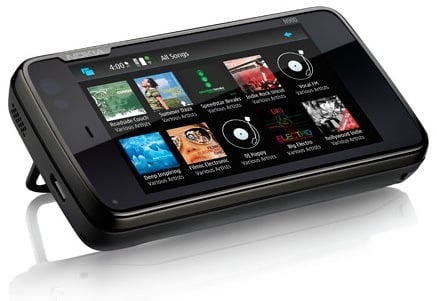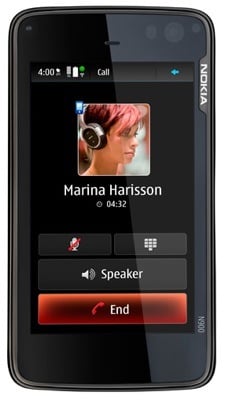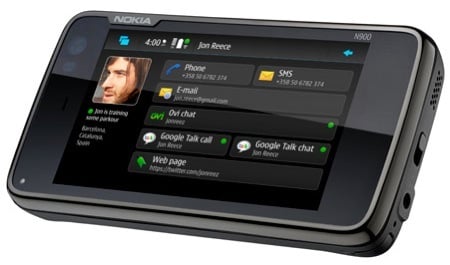 First Look Announced last week, the N900 finally gives Nokia something competitive in the high-end market, and offers a great deal for developers to get excited about. I had a hands on today and came away with fairly positive impressions, for an iPhone user. But more importantly, Nokia has a roadmap that takes it into the next decade.
First Look Announced last week, the N900 finally gives Nokia something competitive in the high-end market, and offers a great deal for developers to get excited about. I had a hands on today and came away with fairly positive impressions, for an iPhone user. But more importantly, Nokia has a roadmap that takes it into the next decade.Qt will become the API across Nokia devices, which means developers might actually start writing applications for them. Qt is much easier for quick and dirty applications, and proven for heavyweights such as Google Earth, Opera and Skype, where high performance is a necessity.
Nokia's Maemo 5-based N900
The Linux stack Maemo looks set to blossom into a range of high-end products, Nokia VP Anssi Vanjoki made very clear today. Symbian will fill the mass-market stubbornly occupied by S40 at present. It will continue to be used for "workhorse smartphones" Nokia says, but Linux is where the investment for high performance devices will now go.
The N900 is the first tablet to fit a shirt pocket. It's heavy, and still a bit nerdy, but it looks more of a 'flagship' than anything Nokia has thrown at the market in the past couple of years. As Vanjoki all but admitted, the N97 was badly in need of a patch-up - he stressed how quickly Nokia was working to address criticism.
But tweaks and patches won't update the two-year-old technology in the device, nor give it a forward-looking UI, which is what Maemo 5 finally offers. So the N900 has some of the glitz and slickness of Android, the iPhone and the Pré. After five minutes, most users should find their way around.
 Nokia's inclusion of cellular telephony has surprised quite a few people. Motorola has thrown thousands of bodies at Linux, without much to show for the effort. A year ago, Linux still couldn't handle UMTS 3G. Meanwhile, the Nokia Internet Tablet has zig-zagged through three generations: first it was internet radio and browsing, then it sprouted a keyboard and was a GPS device.
Nokia's inclusion of cellular telephony has surprised quite a few people. Motorola has thrown thousands of bodies at Linux, without much to show for the effort. A year ago, Linux still couldn't handle UMTS 3G. Meanwhile, the Nokia Internet Tablet has zig-zagged through three generations: first it was internet radio and browsing, then it sprouted a keyboard and was a GPS device.Most of the demand, he said, comes from people who want a data connection rather than a primary phone. And so Nokia finally fulfills the abandoned Hildon roadmap it developed with Psion between 2000 and 2002, that included "palmtops" with embedded data capability. A Series 5 with an embedded modem was just one of the products Psion never brought to market.
No (physical) call buttons
 Jaaksi said that including cellular telephony and data was discussed at the tablet's birth - "what markets could we build out of that?" - but it was simpler to omit it, bypassing the complex approval steps.
Jaaksi said that including cellular telephony and data was discussed at the tablet's birth - "what markets could we build out of that?" - but it was simpler to omit it, bypassing the complex approval steps."They made it very clear that they want a device that integrates the experience of Tablets but with added cellular capabilities. It was critical feedback," he told us.
So really it's because people want to check email or Facebook - another email system, but with knobs on - while out and about, rather than talk to one another.
 "Heavy users need the ubiquitous connectivity more," he said. "Maybe the wireless LAN coverage didn't take off as fast as some people expected. They were talking about wherever you go there will be wireless coverage - that really didn't happen. But 3G really provides the same kind of experience."
"Heavy users need the ubiquitous connectivity more," he said. "Maybe the wireless LAN coverage didn't take off as fast as some people expected. They were talking about wherever you go there will be wireless coverage - that really didn't happen. But 3G really provides the same kind of experience."Maybe in Finland, I pointed out - but er not in the UK.
he device is much more compact than the earlier slabs - the N770, N800 and N810. It feels like a dense package of electronics though - around 30g heavier than the similarly-sized N97, and 45g heavier the much slimmer iPhone...
(By reghardware)


 Sony to launch Vaio P Mark 2 in October
Sony to launch Vaio P Mark 2 in October The netbook 'terrible' best
The netbook 'terrible' best Microsoft Windows 7 Home Premium upgrade for college students $29.99
Microsoft Windows 7 Home Premium upgrade for college students $29.99
 Laptop "sexy" in the world!
Laptop "sexy" in the world! Next week will be tests Firefox version 3.6
Next week will be tests Firefox version 3.6

 Internet Download Manager 5.18 Build 4 + Keygen
Internet Download Manager 5.18 Build 4 + Keygen  AVG Free Edition 9.0 Build 686a1719!
AVG Free Edition 9.0 Build 686a1719! ESET Smart Security 4.0.437 + Keygen +Serials +Crack.A3100!
ESET Smart Security 4.0.437 + Keygen +Serials +Crack.A3100! Kaspersky Internet Security 2010 [FINAL]+NEW KEYS
Kaspersky Internet Security 2010 [FINAL]+NEW KEYS